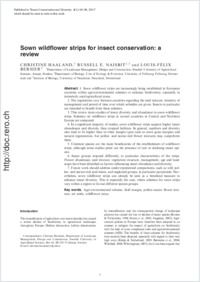Sown wildflower strips for insect conservation: a review
- Haaland, Christine Department of Landscape Management, Design and Construction, Swedish University of Agricultural Sciences, Alnarp, Sweden
- Naisbit, Russell E. Department of Biology, Unit of Ecology & Evolution, University of Fribourg, Switzerland - Institute of Biology, University of Neuchâtel, Neuchâtel, Switzerland
- Bersier, Louis-Félix Department of Biology, Unit of Ecology & Evolution, University of Fribourg, Switzerland
-
10.05.2010
Published in:
- Insect Conservation and Diversity. - 2011, vol. 4, no. 1, p. 60-80
English
1. Sown wildflower strips are increasingly being established in European countries within agri-environmental schemes to enhance biodiversity, especially in intensively used agricultural areas.2. The regulations vary between countries regarding the seed mixture, intensity of management and period of time over which subsidies are given. Insects in particular are intended to benefit from these schemes.3. This review treats studies of insect diversity and abundance in sown wildflower strips. Schemes on wildflower strips in several countries in Central and Northern Europe are compared.4. In a significant majority of studies, sown wildflower strips support higher insect abundances and diversity than cropped habitats. In general, numbers and diversity also tend to be higher than in other margin types such as sown grass margins and natural regeneration, but pollen- and nectar-rich flower mixtures may outperform them.5. Common species are the main beneficiaries of the establishment of wildflower strips, although some studies point out the presence of rare or declining insect species.6. Insect groups respond differently to particular characteristics of the strips. Flower abundance, seed mixture, vegetation structure, management, age and landscape have been identified as factors influencing insect abundance and diversity.7. Future work should address under-represented comparisons, such as with pollen- and nectar-rich seed mixes, and neglected groups, in particular parasitoids. Nevertheless, sown wildflower strips can already be seen as a beneficial measure to enhance insect diversity. This is especially the case, where schemes for sown strips vary within a region to favour different species groups.
- Faculty
- Faculté des sciences et de médecine
- Department
- Département de Biologie
- Language
-
- English
- Classification
- Ecology and biodeversity
- License
-
License undefined
- Identifiers
-
- RERO DOC 28343
- DOI 10.1111/j.1752-4598.2010.00098.x
- Persistent URL
- https://folia.unifr.ch/unifr/documents/302223
Statistics
Document views: 135
File downloads:
- pdf: 575
